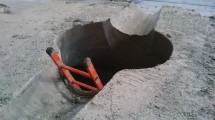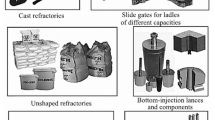This article discusses promising technological measures that can be used to cast ingots. It also examines such issues as multi-ladle casting, optimization of ingot geometry and the chemical composition of the metal being cast, mastery of the production of hollow ingots, stream vacuum-degassing, aspects of the bottom-pouring of large ingots, materials for warming the hot-top part of ingots, protection from secondary oxidation, and high-speed casting. Recommendations are given to improve the technological regimes that are used to cast steel into ingots at Russian plants.



















Similar content being viewed by others
References
A. V. Doub, V. A. Durynin, A. N. Romashkin, et al., “Method of designing a technology for the production of forging ingots,” Tyazh. Mash., No. 7, 21–33 (2012).
A. N. Romashkin, D. N. Tolstykh, A. N. Malginov, et al, “Use of thermal-imaging monitoring systems for the cold modeling of casting processes,” Proc. Int. Sci.-Tech. Conf. Problems of the Casting and Crystallization of Steel,Welding, and Heat Treatment and Mathematical Modeling of Production Processes, Dec. 13–14, 2012, TsNIITMash, Moscow (2012), p. 12.
P. Machovcaka, A. Oplera, and M. Tkadleckovab, “The utilization of numerical modeling to optimize the production of heavy forging ingots in Vitkovice heavy machinery A.S.,” 1st Int. Conf. Ingot Casting, Rolling, and Forging, June 6, 2012, Brüssel-Saal, pp. 1–8.
I. Yasuto, M. Koji, and M. Tomohiro, “Recent technological progress on large ingots for rotor forgings,” Int. Forgemasters Meeting (2011), pp. 166–169.
V. S. Doub, Study of Off-Center Segregation and Development of Methods of Suppressing its Development in Large Ingots: Engin. Sci. Doctoral Dissertation, TsNIITMASh, Moscow (1980), Vol. 1.
A. A. Rebrik, Study of Off-Center Chemical Heterogeneity and Development of Methods of Determining Its Location in Large Ingots: Engin. Sci. Candidate Dissertation, TsNIITMASh, Moscow (1976).
I. I. Makarov, Study of the Effect of the Hot-Top Parameters on the Kinetics of Solidification of Steel and the Formation of Shrinkage Defects in Large Ingots: Engin. Sci. Cand. Dissert., TsNIITMASh, Moscow (1976).
A. V. Doub,V. S. Doub, E. V. Makarycheva, et al, “Factors in controlling solidification processes,” Elektrometallurgiya, No. 11, 18–22 (2006).
A. V. Doub, Physicochemical Principles of Controlling Processes in the Formation of the Primary Structure and Service Properties of Low-Alloy Steels [in Russian], MISIS, Moscow (2000).
B. Chalmers, Theory of Solidification [Russian translation], Metallurgiya, Moscow (1968).
R. J. Stofanak, T. J. Poskie, Y. Y. Li, et al., Irradiation Damage Behavior of Low Alloy Steel Wrought and Weld Materials, Westinghouse Electric Corporation, Beitis Laboratory, West Mifflin, PA 15122.
U. Takashi, S. Tadashi, U. Sou, et al., “Dehydronation in large ingot casting process,” Int. Forgemasters Meeting (2009).
T. Yasuji, Y. Hiroshi, Haruhiko, Naruse, et al., “Advanced ladle to ladle stream degassing method in JCFC,” ibid.
S. I. Zhul’ev and N. A. Zyuban, Manufacture of Forging Ingots and Problems with Their Quality [in Russian],VolgTU, Volgograd (2003).
A. N. Romashkin, E. V. Makarycheva, A. V. Dub, et al., Russian Federation Patent No. 2406768, IPC C21C7/00, Method of Degassing Steel, subm. 05.29.2009, publ. 12.20.2010.
S. Z. Afonin, V. M. Parshin, A. V. Larin, et al., Russian Federation Patent No. 2082543, IPC8 B22D11/10, Method of Vacuum Degassing of Metal during Casting and Equipment for Its Implementation, subm. 02.07.1994, publ. 06.27.1997.
M. Tomlinson, J. Talamantes-Silva, and P. Davies, “The development of hollow ingot technology at Sheffield Forgemasters Int., Ltd,” Int. Forgemasters Meeting, (2011), pp. 175–178.
“Forgemasters trials hollow ingot casting,” World Nuclear News, 11.25.2010, www.world-nuclear-news.org.
G. Giradin, D. Jobard, F. Perdriset, et al., “Hollow ingots: thirty years of use to control segregation and quality for nuclear and petrochemical large shells,” Int. Forgemasters Meeting (2011), pp. 170–174.
Sang-Hun Oh, Jung Namkung, Seog-Ou, et al., “A study on the fabrication of large hollow ingot by CAE,” ibid., pp. 179–182.
M. V. Kolodkin, S. I. Zhul’ev, V. S. Doub, et al., “Choice of a rational scheme for casting of a forging ingot for producing hollow forgings,” Russian Metallurgy (Metally), 2010, No. 6, 544–547 (2010).
I. L. Akaro, R. A. Andrievskii, A. F. Arzhanov, et al., Encyclopedia. Mechanical Engineering, Vol. III-2, Technologies in Semifinished Products Manufacturing [in Russian], Mashinostroenie, Moscow (1996).
V. S. Doub, A. N. Romashkin, A. N. Malginov, et al., “Technology for making hollow ingots,” Elektrometallurgiya, No. 2, 17–37 (2013).
M. V. Kolodkin, A. N. Romashkin, and A. N. Malginov, “Developing a special ingot-casting technology to improve technical-economic indices in the production of hollow forgings,” Tyazh. Mash., No. 6, 24–29 (2010).
M. V. Kolokin, S. I. Zhul’ev, V. S. Doub, and A. N. Romashkin, “Choosing an efficient scheme for casting foundry ingots to make hollow castings,” Elektrometallurgiya, No. 8, 26 (2009).
M. Novak, “Production aspects and materials evaluation of the forged nuclear cask from 170 tons bottom poured ingot,” Int. Forgemasters Meeting, (2009).
V. D. Solodovnikov, Improving the Technology for Making, Vacuum-Degassing, and Casting Steel for Cold-Rolling-Mill Rolls: Engin. Sci. Candidate Dissertation, TsNIITMASh, Moscow.
A. N. Smirnov, S. L. Makurov, V. M. Safonov, et al., Large Ingot [in Russian], Veber, Donetsk (2009).
V. A. Shteklein, A. N. Shamanov, and A. V. Kovrizhnykh, “Improving the quality of bottom-poured steel at MZ Kamastal,” Stal, No. 11, 50–52 (2008).
L. Zhang, B. Rietow, B. G. Thomas, et al., “Large inclusions in plain-carbon steel ingots cast by bottom teeming,” ISIJ Int., 46, No. 5, 670–679 (2006).
Author information
Authors and Affiliations
Corresponding author
Additional information
Translated from Metallurg, No. 6, pp. 31–44, June, 2013.
Rights and permissions
About this article
Cite this article
Doub, V.S., Romashkin, A.N. & Malginov, A.N. Main Trends in the Development of Technology for Casting Steel into Ingots. Metallurgist 57, 487–504 (2013). https://doi.org/10.1007/s11015-013-9759-0
Received:
Published:
Issue Date:
DOI: https://doi.org/10.1007/s11015-013-9759-0




